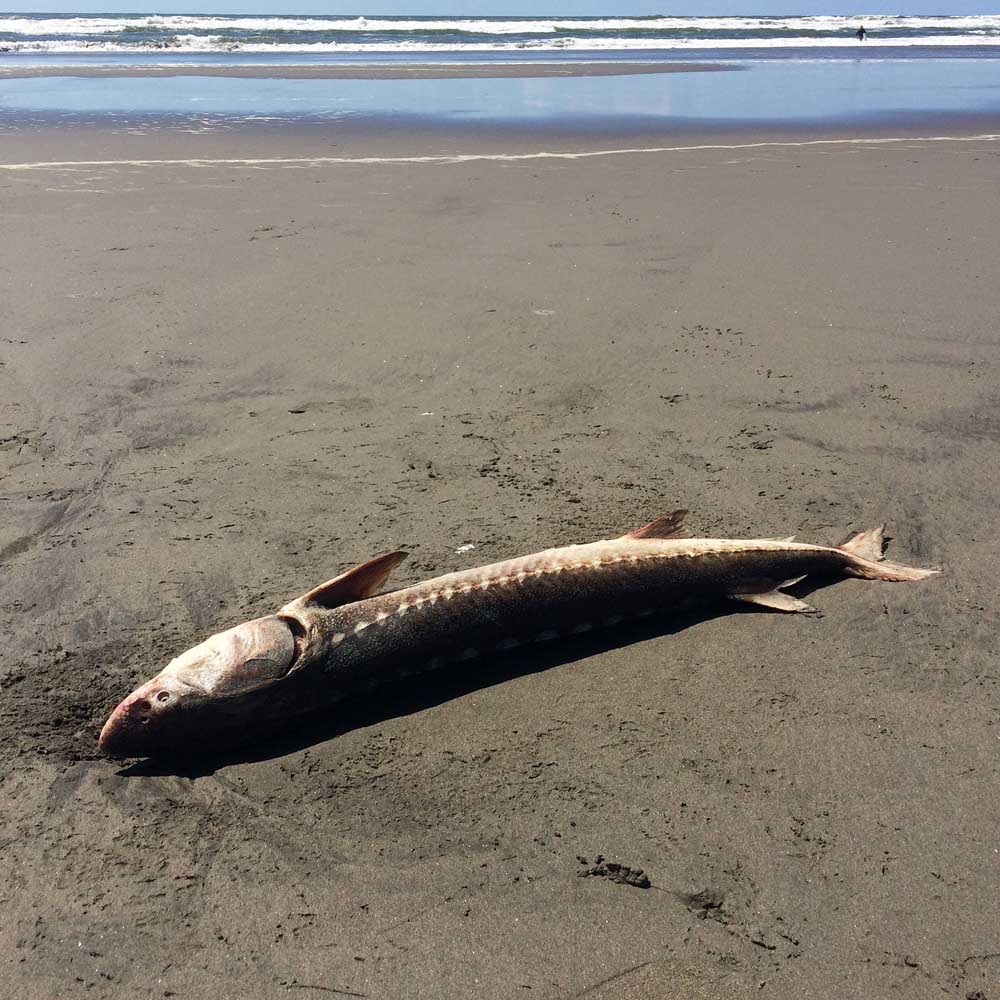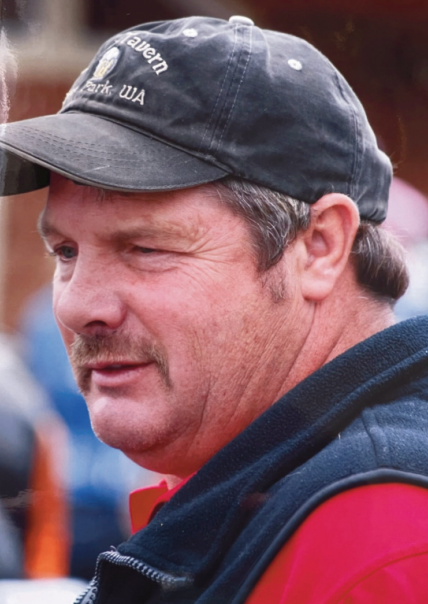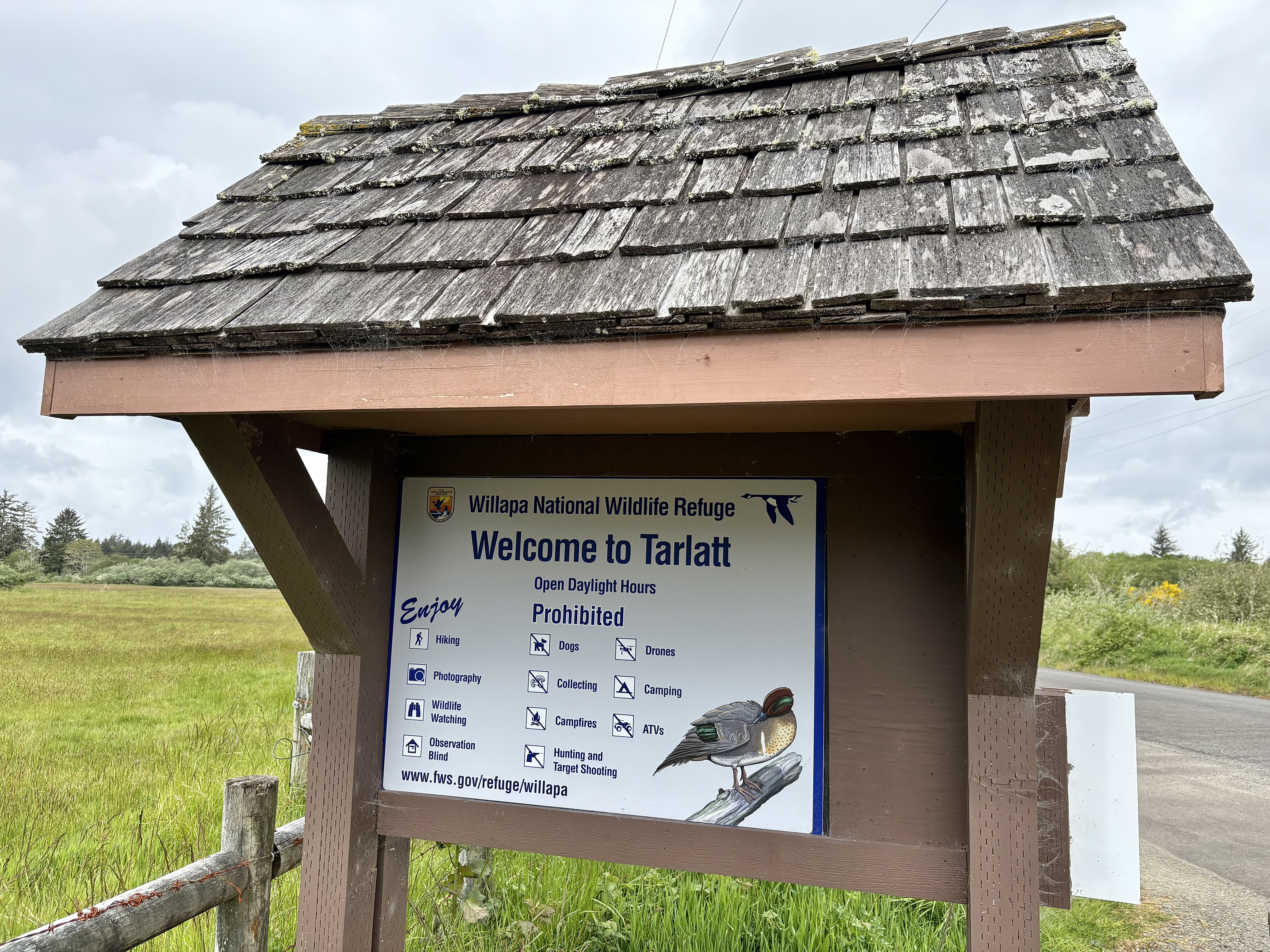White sturgeon numbers decent; Some upriver populations show decline
Published 10:23 am Tuesday, April 24, 2018

- This large sturgeon washed up on Benson Beach in Cape Disappointment State Park last year. In general, Lower Columbia sturgeon stocks are improving — enough to allow a retention season this spring.
COLUMBIA RIVER — After years of low abundance of legal-sized and adult-sized white sturgeon in the Lower Columbia River downstream of Bonneville Dam, the numbers of fish are beginning to improve, according to a summary of sturgeon abundance throughout the Columbia and Snake rivers presented at the Northwest Power and Conservation Council meeting earlier this month in Portland.
Trending
However, abundance of the fish is declining in the Snake River, while efforts to rebuild sturgeon populations at Lake Roosevelt and in the Kootenai River are seeing some success.
Legal-sized fish — 38 to 54 inches in length — are those targeted in the river downstream of Bonneville by both commercial and recreational retention fisheries, Art Martin, Columbia River Coordination section Manager with Oregon Department of Fish and Wildlife told the Council’s Fish and Wildlife Committee April 10.
Some 635,530 white sturgeon are estimated to inhabit that area of the river, but when the number is broken down by size, the story is mixed. Of the larger number, 393,602 are juveniles (22 to 38 inches), 199,830 are legal-sized, 31,681 are over-legal (54 to 65 inches) and 10,417 are adults and considered broodstock. Although lower than in 2016, the number of legal fish is still 39 percent more than in 2015.
Trending
Adults, which are 20 to 30 years old, spawn every 3 to 5 years, Martin said, and can live to be over 100 years old. “A robust population of adults protects against lean times and allows for rapid increases in juvenile abundances when conditions are right,” he said.
Juvenile fish encompass 62 percent of the total sturgeon population in the lower river: however, the desired status based on Oregon’s White Sturgeon Conservation Plan is 95 percent of the total population in that section of the river.
Sub-adults (over legal) make up 36.4 percent of the population, a much higher percentage than the desired 4.5 percent. Adults in 2017 make up an estimated 1.6 percent of the population, far higher than the 0.5 percent desired abundance.
“The take-home is that we have a decreasing population of juveniles,” Martin said, adding that while the Lower Columbia population “is not where we’d like to see it, the population is not in danger. These are very long-lived fish; they can handle a few years of decreased recruitment, but not a sustained lack of recruitment.”
Still, he said, the population is sufficiently robust to support limited fisheries in 2018, similar to those allowed in 2017.
Recruitment means the number of fish reaching a life history stage such as larvae to year-old fish, or juveniles to reproductive age, the Council’s John Harrison said in an April 12 blog (www.nwcouncil.org/news/blog/sturgeon-update-april-2018/).
Sea lion predation of sturgeon is an issue in both the Lower Columbia and Willamette Rivers, and Steller sea lions are the main culprits.
At the peak in 2011, Oregon and Washington estimated that sea lions consumed over 10,000 sturgeon in one season throughout the 145 miles of the lower Columbia River. The good news is that predation has dropped significantly, Martin said.
Recruitment is a problem for white sturgeon populations farther upriver, in the reservoirs behind each dam on the Columbia and Snake rivers, according to Blaine Parker of the Columbia River Inter-Tribal Fish Commission. “There is a much smaller population of sturgeon upstream of Bonneville Dam than downstream,” he said.
Each of the reservoirs — Bonneville, The Dalles and John Day — is assessed every three years, Parker said.
In the reservoir between John Day and McNary dams (Lake Umatilla), for example, the entire population, adults and juveniles, is declining, he said. Lack of recruitment has been an issue for many years. Sturgeon densities are an order of magnitude less in Lake Umatilla than in the other reservoirs, and the population is “a strong candidate for supplementation” with hatchery fish.
Total estimated abundance of white sturgeon of all sizes in the Bonneville pool in 2015 was 191,893. For The Dalles pool total abundance in 2017 was 82,880, down from 133,259 in 2008. The John Day pool total abundance in 2016 was estimated at 29,290 fish, down from 42,622 in 2007.
Declines in abundance are also found in the Lower Snake River, Laura Heironimus of the Washington Department of Fish and Wildlife said. Sturgeon in the reservoirs behind Ice Harbor, Lower Monumental, and Little Goose dams have only been assessed twice since the late 1990s, and a comparison shows the populations have declined.
“The trend is pretty flat with some small increases, probably as the result of high spring flows in some years,” she said. High spring flows are important for sturgeon spawning. “We see older, larger fish in the populations, but overall it’s a pretty random recruitment and a flat population. We’re not seeing the large numbers of juveniles we would like to see.”
The abundance of white sturgeon larger than 54 inches fork length in the reservoir behind Ice Harbor has dropped from an estimated 4,830 fish in 1996 to 2,235 fish in 2014, Heironimus said.
The estimated abundance of white sturgeon greater than 54 inches in the Lower Monumental pool in 2012 was 2,230 in 1997 and a 2012 estimate did not have sufficient data to come up with a number. Little Goose was 4,180 in 2012 and a previous estimate from 1997 is unknown.
In the upper Columbia in Lake Roosevelt behind Grand Coulee Dam, where the Spokane and Colville tribes, and WDFW, have been implementing a white sturgeon recovery plan since 2002, there is some good news. The plan includes releasing hatchery-raised juvenile fish — about 150,000 since 2002 — at multiple locations in Washington and British Columbia, and capturing wild-spawned larvae for the hatchery. The program has been successful — the wild population is estimated at about 2,500 adults, but like other areas of the Columbia, there is a continuing lack of juvenile recruitment in the wild, according to Jason McLellan of the Colville Tribes.
However, survival of the hatchery fish is high, especially when the fish are released at age one year, he said. The hope is that continued supplementation will boost wild recruitment over time. Meanwhile, in order to balance hatchery production with genetic management of the species (there were an estimated 2,500 wild adult sturgeon in Lake Roosevelt in 2016), the state has allowed harvest of hatchery fish and about 3,500 were harvested in 2017.
Work continues to reestablish the Kootenai River white sturgeon population, which is listed as endangered under the federal Endangered Species Act. The effort is through a collaborative effort to improve spawning and rearing habitat in the Kootenai River and supplement the population with fish from two hatcheries operated by the Kootenai Tribe of Idaho
“Co-managing agencies, such as Idaho Department of Fish and Game, provide valuable information from research, monitoring, and evaluation of hatchery fish after release to adaptively manage the conservation aquaculture program,” Ryan Hardy of IDFG said.
Juvenile recruitment of wild fish is a problem, but this spring the tribe caught the first sexually mature male adult sturgeon that had been released into the river with the first group of fish raised at the original hatchery, 26 years ago.
“We’re guardedly optimistic because we still have extremely low natural recruitment, but we do recognize the long horizon of sturgeon,” Shawn Young of the Kootenai Tribe said.









